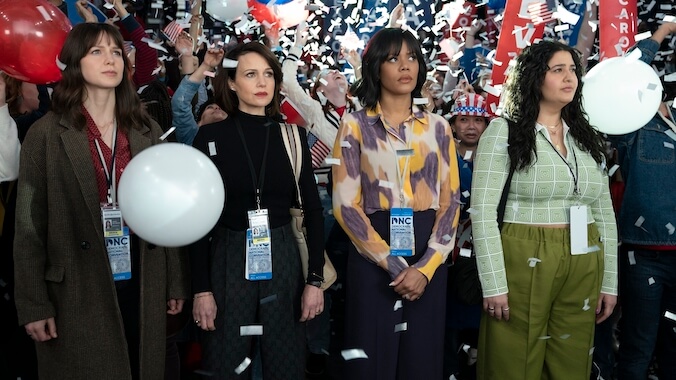Despite Its Flaws, Max’s The Girls on the Bus Is an Unexpected Delight
Photo Courtesy of Max
In Max’s The Girls on the Bus, loosely based on the novel Chasing Hillary by Amy Chozick, the titular girls—Sadie (Melissa Benoist), Grace (Carla Gugino), Lola (Natasha Behnam), and Kimberlyn (Christina Elmore)—are assigned to the same bus to provide exclusive campaign coverage of the candidates in the running to become the Democratic nominee in the upcoming presidential election. After watching all 10 episodes of the first season, it’s safe to say that The Girls on the Bus is highly enjoyable, though not without a fair amount of flaws.
Each of these women represents a very different angle of how viewers may look at any election, providing someone for (nearly) everyone—at least anyone interested in watching this show—to relate to. Sadie stands in for liberal millennials. Lola is supporting the socialist candidate and amping up her following on socials, while Grace is the Gen X cynic who has lost hope in the election meaning anything. On the other hand, Kimberlyn is the voice of the centrist conservatives, forced to follow the democrats on the trail by her superiors at the Fox News stand-in network.
The characters are relatable, struggling to manage the messes they left behind for their seats on the bus. As they chase their work and any scoop they can get, they deal with a great amount of turmoil. Grace grapples with her daughter, who has recently become an adult and is struggling with college. Sadie has relationship issues; namely, she’s kind of involved with a man she shouldn’t be seeing, lest she face complications with her work. Kimberlyn is newly engaged and her fiancé is bombarding her with wedding planning as she tries to do her job from the road and hotel rooms. As for Lola, she is forced to prove herself as nobody takes her or her social media following seriously, all the while struggling to make ad content to pay for her way on the trail.
Plus, mysterious clues and haunting revelations come to light on the trail that changes their respective views and approaches to their work as the series progresses, impressing upon them the weight that this election holds for the future of the nation. Truly, they are in precarious positions all around, which provides excellent drama and emotional moments on all fronts. From start to finish, the series entertains, excites, and embraces the viewer, which seems like a tall order these days, telling a story that is a bit hard to watch given the truthfulness behind it and the state of the world but, as a result, feels somewhat cathartic.
However, the series has quite a few issues. Most notably, the pacing. The Girls on the Bus feels like it is just barely crawling forward at certain times throughout the season while other episodes are completely packed with movement. There’s a very obvious struggle to find the right balance between the personal and professional aspects that unfortunately isn’t solved during the season. If anything, the final two episodes showcase this glaring issue.
That said, despite its flaws, there are four simple reasons to watch The Girls on the Bus: Benoist, Gugino, Elmore, and Behnam. The series could not have asked for better performers to play the titular reporters. Each brings immense talent with them, fully embracing their characters and allowing them to breathe amidst a plot-heavy story that so often separates them into their own worlds. And their chemistry with one another completely elevates the relationships between them.
-

-

-

-

-

-

-

-

-

-

-

-

-

-

-

-

-

-

-

-

-

-

-

-

-

-

-

-

-

-

-

-

-

-

-

-

-

-

-

-








































